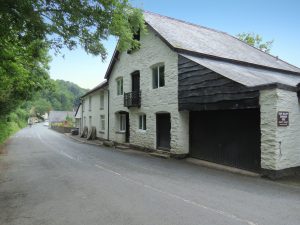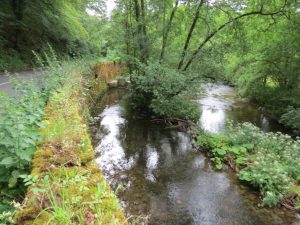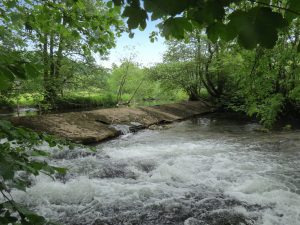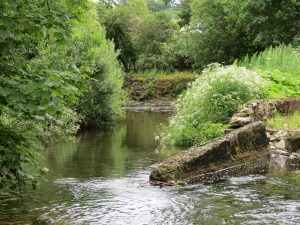
Location :51.06541,-3.53712
A mill leat is recorded on historic mapping. It carries water from a weir on the River Exe to Bridgetown Mill to the south. A weir is marked on historic mapping, with the downstream side labelled “Shetter’s Pool”. A leat leaves the river on the upstream side of the weir. A salmon leap is also present on the weir. A mill is recorded on historic mapping and has a low breastshot water wheel.
References: Exmoor HER – MEM24927 – Post-medieval mill leat at Bridgetown, and MEM24926 – Shetter’s Pool and post-medieval weir north of Bridgetown, and MEM15204 – Bridgetown Mill, Exton
Full Description
MEM24927 – The Tithe Map for Exton Parish depicts a mill leat commencing at a weir on the River Exe north of Bridgetown, at SS 9233 3376. It runs south to a mill situated at SS 9233 3330 (MEM15204) before returning to the Exe at SS 9232 3321.
The feature is depicted on the 25 inch 1st Edition Ordnance Survey map and is labelled “Mill Leat”.
The leat is also shown on the 2021 MasterMap data.
A report relating to works undertaken at Bridgetown Weir mentions the history of the mill . There appears to be no documentary evidence for the mill and leat prior to the mid 19th Century, although a draft conveyance of a water mill in Exton dating from 1827 and held in the Somerset Heritage Centre may refer to the water mill at Bridgetown. There is no clear evidence for the leat on the surveyors draft maps of the area, although it is limited in detail and a boundary shown does run along its approximate line.
The leat runs broadly parallel to the river for c. 450 metres down to the mill. It is flanked by a retaining wall for the A396 road, and by a low wall of dressed blocks to the west. It has a sharp rectangular profile, deep and carrying a large volume of water, and is well maintained. A relatively modern sluice gate is between the leat and river.
MEM24926 – The Tithe Map for both Winsford and Exton Parishes depicts a mill leat leaving the River Exe at SS 9232 3377. The river forms the boundary between the two Parishes.
The 25 inch 1st Edition Ordnance Survey map depicts a weir in this location, with the downstream side labelled “Shetter’s Pool”. A leat (MEM24927) leaves the river on the upstream side of the weir, which may have been constructed to facilitate this.
The weir is shown and labelled on 2021 MasterMap data, as is the pool. The leat also appears to be in situ at this time. A salmon leap is also labelled on the northwestern end of the weir, at SS 9231 3378.
A programme of archaeological monitoring and recording was undertaken during the permitted works to Bridgetown Weir, situated on the River Exe. An assessment was undertaken in 2021, the results of which were combined with further recording during works in August 2022.
The structure is built as a long cranked diagonal weir, with a sluice and leat to the southsoutheast and a fish passage inserted to the northwest. It is mainly built of local sandstone, shale and slate, with later additions of concrete and cement braced with iron pins and wires. All of the weir(s)’ elements would be described as low guage weirs; the northern element is in the form of an earlier crump weir and the lower element to the southern end is classed as a narrow crested drop weir, associated with the leat and sluice gate to the mill and possibly a later reconstruction. The overflow gate, flank wall and sluice gate are of a neat, functional character and are of the same build. A section of shuttered concrete associated with blocks and cement filled sandbags infills the former overflow gate. There are two phases of mixed stone builders at the southern end, pinned in front and possibly intended to alter the water flow here and strengthen the structure.
The weir is associated with a mill leat (MEM24927) that leads to Bridgetown Mill (MEM15204). The regularity of the banks above the rear, which feature underbuilding and revetment banking to sections of the western riverbank, were stated to suggest the course of the river has been considerably engineered at this location to serve the mill.
A draft conveyance of a water mill in Exton dating from 1827 and held in the Somerset Heritage Centre may refer to the water mill at Bridgetown. The surveyors draft maps show no clear evidence for the weir weir and pool, although they may have been in existance by this date.
A further document dated 1954 relates to the installation of the fish pass. This is possibly associated with the establishment of the National Park, with the pool in front formed in 2012 by the Westcountry Rivers Trust. It has thick cinder wall blocks rendered in cement and runs straight through the weir, widening into a square bowl at the end, emptying into a pool. It was designed to allow the structure to be closed off, but any sluice gate that was extant has been removed or rotted away.
MEM15204 – The mill has a low breast all iron wheel, 14′ diameter, 4′ wide, with 19″ deep side plates and 40 paddles curved to 23″ deep.
The mill building shows on the 1st and 2nd ed. Ordnance Survey mapping as “Bridgetown Corn Mill”.
The mill is mentioned in a publication on the industrial archaeology of Somerset, which states that the late 19th Century machinery is in full working order, although no longer grinding, and is now incorporated into the building’s living space.
The building is labelled “Mill House” on the 2022 MasterMap data.
A report relating to works undertaken at Bridgetown Weir mentions the history of the mill and its occupants. A draft conveyance of a water mill in Exton dating from 1827 and held in the Somerset Heritage Centre may refer to the water mill at Bridgetown. The surveyors draft map for the area may or may not show a building in this location, which if present appears to have been on a different orientation to the building shown on the Tithe Map.



